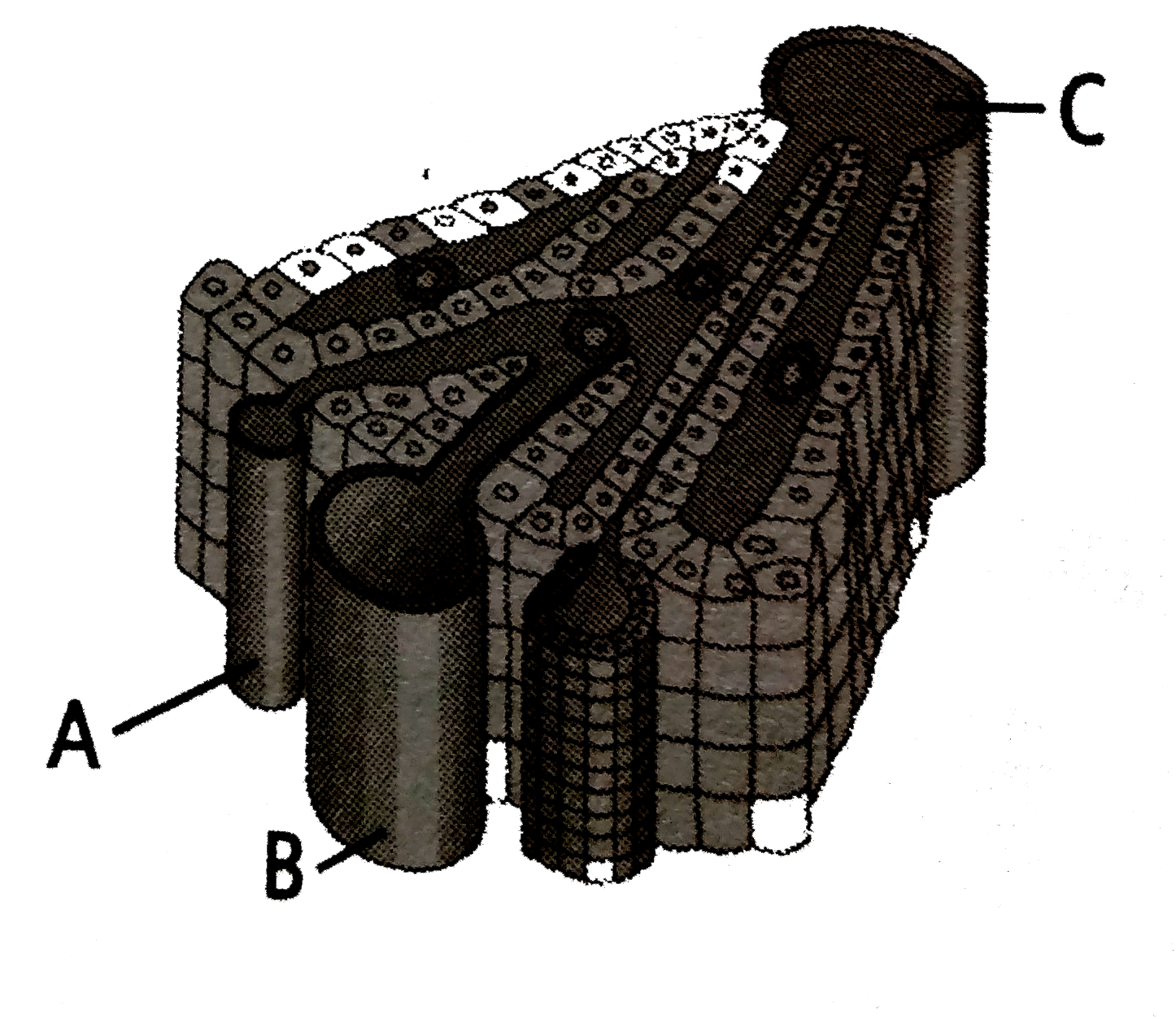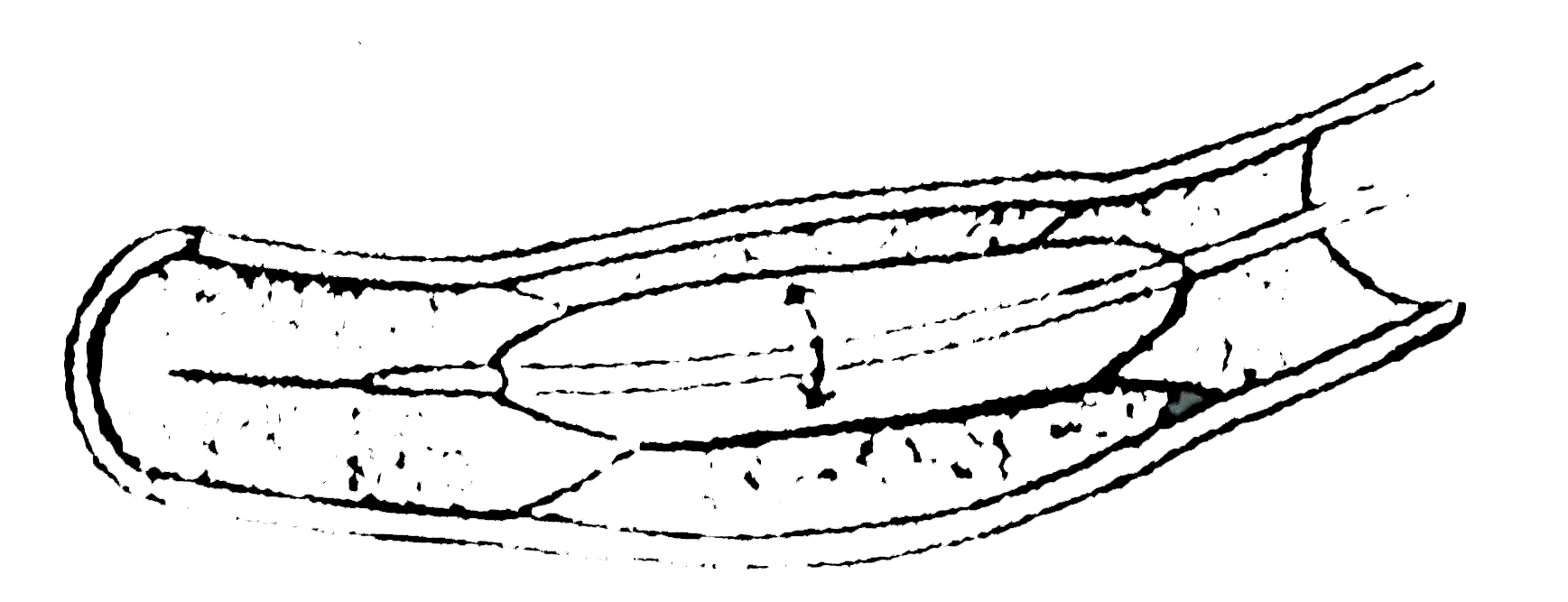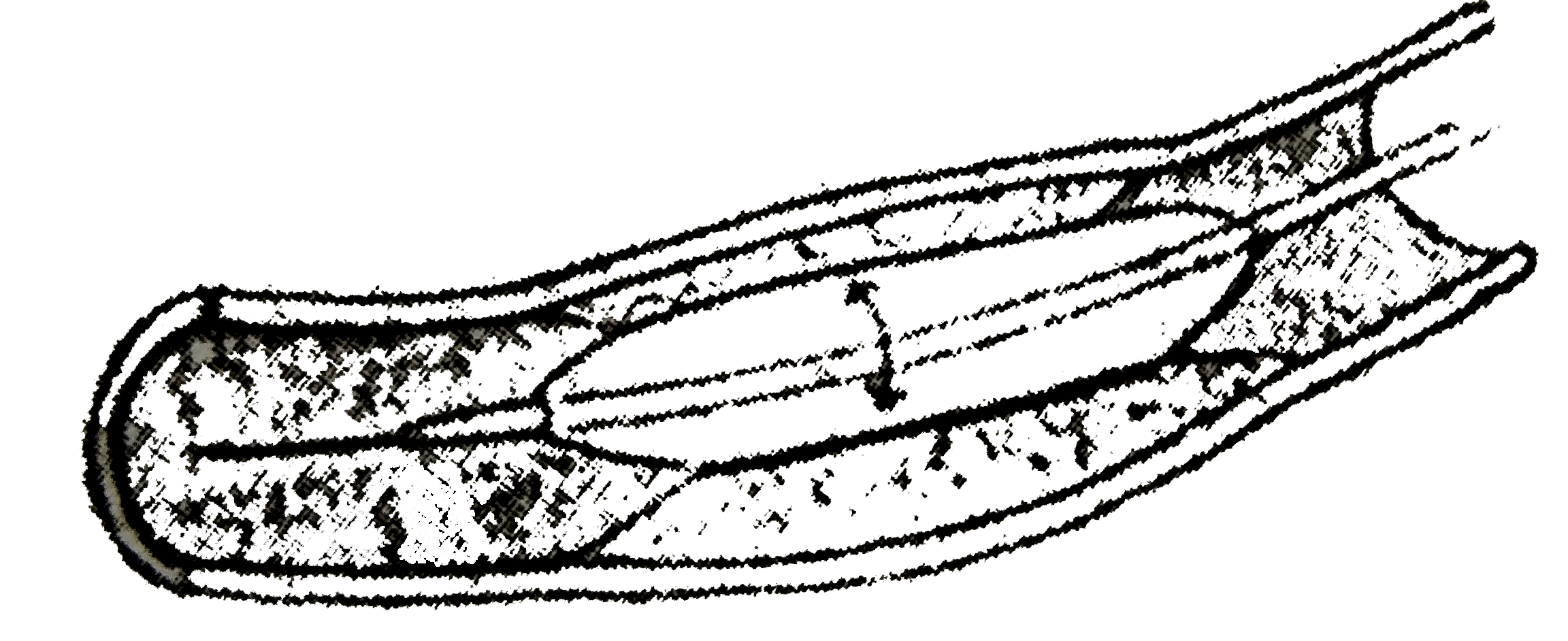The given dissection figure shows the blood vessels in liver tissue. The three main blood vessels are indicated by capital letters (A-C). Following statements describe properties of blood that flows through these blood vessesl. For each description, indicate the vessel where that blood would be found.
(i) Blood with the highest oxygen content.
(ii) Blood that contains newly absorbed nutrients.
(iii) Deoxygenated blood.

i-A,ii-C,iii-B
i-A,ii-B,iii-C
i-C,ii-A,iii-B
i-C,ii-B,iii-A
The correct Answer is:B
A,B and C in the diagram represent hepatic artery, hepatic portal vein and hepatic vein respectively.
Topper's Solved these Questions
- BOOK - NCERT FINGERTIPSCHAPTER - CHEMICAL COORDINATION AND INTEGRATIONEXERCISE - Chemical Coordination And Integration135videos
CHEMICAL COORDINATION AND INTEGRATION
- BOOK - NCERT FINGERTIPSCHAPTER - EXCRETORY PRODUCTS AND THEIR ELIMINATIONEXERCISE - Excretory Products And Their Elimination133videos
EXCRETORY PRODUCTS AND THEIR ELIMINATION
Similar Questions
The figure bleow shows an angiogram of the coronary blood vessel. Which one of the following statements correctly describes, what is being done.
 View Solution
View SolutionThe human body has an organ A which acts as a double pump. The oxygenated blood coming from the lungs through a blood vessel B enters the upper left chamber C of the double pump. When chamber C contract, then blood goes into lower left chamb D. The contraction of chamber D forces the blood to go into a blood vessel E which supplies oxygenated blood to all the organs of the body (except the lungs). The deoxygenated blood coming out of the body organs is taken by a blood vessel F to the right upper chamber G of pumping organ. Contraction of chamber G force the deoxygenated blood into right lower chamber H. And finally the contraction of chamber H sends the deoxygenated blood into lungs through a blood vessel I.
(a) What is organ A?
(b) Name the blood vessel (i) B (ii) E (iii) F, and (iv) I
(c) What are chambers (i) G and (ii) H ?
(d) What are chambers (i) G and (ii) H ?View Solution
Knowledge Check
- Question 1 - Select One
The given figure shows an angiogram of the coronary blood vessel. Which one of the following statements correctly describes, what is being done ?
 AIt is a coronary artery which has a cancerous growth that is being removed.BIt is a coronary artery which is blocked by a plaque and the same is being crackedCIt is a coronary vein in which the defective valves are beings openedDIt is coronary vein blocked by a parasite (blood fluke) that is being removed.
AIt is a coronary artery which has a cancerous growth that is being removed.BIt is a coronary artery which is blocked by a plaque and the same is being crackedCIt is a coronary vein in which the defective valves are beings openedDIt is coronary vein blocked by a parasite (blood fluke) that is being removed. - Question 2 - Select One
Find the odd one among the following blood vessels w.r.t. the blood (deoxygenated or oxygenated ) which is carried by them?
APulmonary arteryBPulmonary veinCCoronary veinsDVena cava - Question 3 - Select One
Note the following blood vessels -
A. Arteriole
B. Capillary
C. Aorta
D. Muscular artery
E. Vein
F. Venule
Choose the correct path that lists the blood vessels in order, blood passes through them as it leaves the heart, travels to tissue and returns to heart-AC, D, B, A, E, FBC, D, A, B, F, ECD, C, A, B, E, FDD, C, B, A, E, F
William Harvey (1578–1657) was one of the early biologists who studied the bodies of humans and animals. He even dissected the bodies and did experiments with the heart and blood vessels. He concluded from his experiments that the blood leaves the heart through the arteries and returns via the veins. However, he could not explain how blood left the arteries to enter the veins. He said there must be some structure between arteries and veins but he could not find them. Marcello Malphigi (1628–1694) later discovered these structures while studying a dead frog's lungs under a microscope.
Which of the following statements about arteries and veins is TRUE?View SolutionWilliam Harvey (1578–1657) was one of the early biologists who studied the bodies of humans and animals. He even dissected the bodies and did experiments with the heart and blood vessels. He concluded from his experiments that the blood leaves the heart through the arteries and returns via the veins. However, he could not explain how blood left the arteries to enter the veins. He said there must be some structure between arteries and veins but he could not find them. Marcello Malphigi (1628–1694) later discovered these structures while studying a dead frog's lungs under a microscope.
Which of the following structures did Malphigi find in the frog?View SolutionRead the statements and select the option which best describes the process that occurs during systemic circulation.
(i) The left atrium receives the oxygenated blood through the pulmonary veins. The left ventricle pumps the blood through the aorta to various parts and the deoxygenated blood reaches right atrium.
(ii) The left atrium receives the oxygenated blood through pulmonary veins and pumps the blood through the aorta to various parts and the deoxygenated blood reaches the right atrium.
(iii) The left atrium receives deoxygenated blood and pumps into left ventricles which in turn pumps into pulmonary artery for oxygenation.
(iv) The right atrium receives the deoxygenated blood and pumps into pulmonary artery for oxygenation.View SolutionThe blood flows strictly by a fixed route through blood vessels, the arteries and veins. Basically, each artery and vein consists of three layers. Which of the following layer consists of smooth muscles elastic fibres?
View SolutionFour statements are given below about human heart . Which one of them is/are correct ?
(i) Right atricle receives deoxygenated blood from different parts of the body while left ventricle pumps oxygenated blood to different parts of body.
(ii) Lift atricle sends oxygenated blood to right ventricle which pumps it to different parts of body.
(iii) Left atricle receives oxygenated blood from different parts of body while right auricle receives deoxygenated blood from lungs.
(iv) Left ventricle pumps oxygenated blood to different body parts while right ventricle pumps deoxygenated blood to lungs.View Solution

